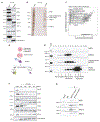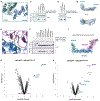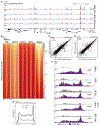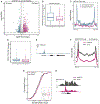A combinatorial approach to uncover an additional Integrator subunit
- PMID: 36920904
- PMCID: PMC10312363
- DOI: 10.1016/j.celrep.2023.112244
A combinatorial approach to uncover an additional Integrator subunit
Abstract
RNA polymerase II (RNAPII) controls expression of all protein-coding genes and most noncoding loci in higher eukaryotes. Calibrating RNAPII activity requires an assortment of polymerase-associated factors that are recruited at sites of active transcription. The Integrator complex is one of the most elusive transcriptional regulators in metazoans, deemed to be recruited after initiation to help establish and modulate paused RNAPII. Integrator is known to be composed of 14 subunits that assemble and operate in a modular fashion. We employed proteomics and machine-learning structure prediction (AlphaFold2) to identify an additional Integrator subunit, INTS15. We report that INTS15 assembles primarily with the INTS13/14/10 module and interfaces with the Int-PP2A module. Functional genomics analysis further reveals a role for INTS15 in modulating RNAPII pausing at a subset of genes. Our study shows that omics approaches combined with AlphaFold2-based predictions provide additional insights into the molecular architecture of large and dynamic multiprotein complexes.
Keywords: AlphaFold2; CP: Neuroscience; Integrator complex; RNA polymerase II; RNA polymerase II pausing; large protein complexes; molecular modeling; omics; pause-release; transcription; transcription factors; transcriptional regulation.
Copyright © 2023 The Author(s). Published by Elsevier Inc. All rights reserved.
Conflict of interest statement
Declaration of interests The authors declare no competing interests.
Figures






Similar articles
-
Structural basis of Integrator-dependent RNA polymerase II termination.Nature. 2024 May;629(8010):219-227. doi: 10.1038/s41586-024-07269-4. Epub 2024 Apr 3. Nature. 2024. PMID: 38570683 Free PMC article.
-
Integrator is a global promoter-proximal termination complex.Mol Cell. 2023 Feb 2;83(3):416-427. doi: 10.1016/j.molcel.2022.11.012. Epub 2023 Jan 11. Mol Cell. 2023. PMID: 36634676 Free PMC article. Review.
-
Integrator endonuclease drives promoter-proximal termination at all RNA polymerase II-transcribed loci.Mol Cell. 2022 Nov 17;82(22):4232-4245.e11. doi: 10.1016/j.molcel.2022.10.004. Epub 2022 Oct 28. Mol Cell. 2022. PMID: 36309014 Free PMC article.
-
Integrator complex regulates NELF-mediated RNA polymerase II pause/release and processivity at coding genes.Nat Commun. 2014 Nov 20;5:5531. doi: 10.1038/ncomms6531. Nat Commun. 2014. PMID: 25410209 Free PMC article.
-
Genomic regulation of transcription and RNA processing by the multitasking Integrator complex.Nat Rev Mol Cell Biol. 2023 Mar;24(3):204-220. doi: 10.1038/s41580-022-00534-2. Epub 2022 Sep 30. Nat Rev Mol Cell Biol. 2023. PMID: 36180603 Free PMC article. Review.
Cited by
-
Integration of long-read sequencing, DNA methylation and gene expression reveals heterogeneity in Y chromosome segment lengths in phenotypic males with 46,XX testicular disorder/difference of sex development.Biol Sex Differ. 2024 Oct 8;15(1):77. doi: 10.1186/s13293-024-00654-8. Biol Sex Differ. 2024. PMID: 39380113 Free PMC article.
-
Integrator complex subunit 12 knockout overcomes a transcriptional block to HIV latency reversal.Elife. 2025 Apr 10;13:RP103064. doi: 10.7554/eLife.103064. Elife. 2025. PMID: 40207620 Free PMC article.
-
Catalytic-independent functions of the Integrator-PP2A complex (INTAC) confer sensitivity to BET inhibition.Nat Chem Biol. 2025 Jun;21(6):959-970. doi: 10.1038/s41589-024-01807-x. Epub 2025 Jan 14. Nat Chem Biol. 2025. PMID: 39809894
-
The enhancer module of Integrator controls cell identity and early neural fate commitment.Nat Cell Biol. 2025 Jan;27(1):103-117. doi: 10.1038/s41556-024-01556-y. Epub 2024 Nov 26. Nat Cell Biol. 2025. PMID: 39592860 Free PMC article.
-
Structural basis of Integrator-dependent RNA polymerase II termination.Nature. 2024 May;629(8010):219-227. doi: 10.1038/s41586-024-07269-4. Epub 2024 Apr 3. Nature. 2024. PMID: 38570683 Free PMC article.
References
Publication types
MeSH terms
Substances
Grants and funding
LinkOut - more resources
Full Text Sources
Molecular Biology Databases
Research Materials
Miscellaneous

